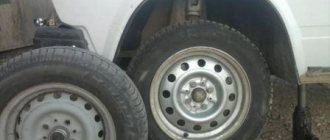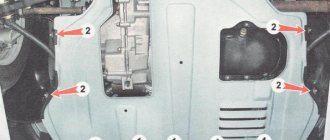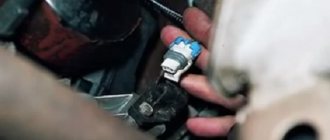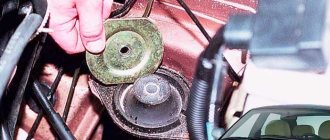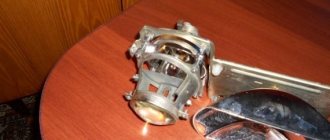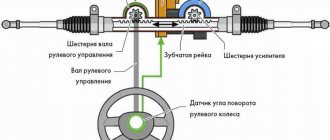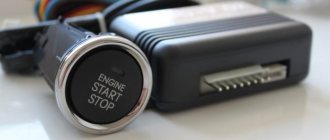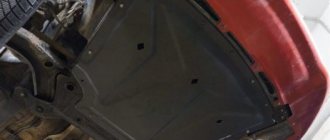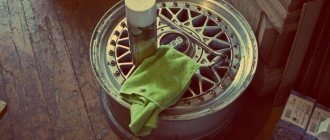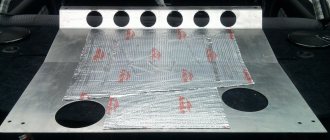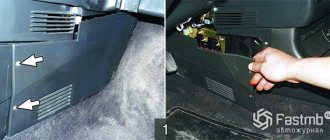Many owners of domestic cars are concerned about the issue of protecting the engine of their car. And all because the plant does not provide for the installation of anything significant.
No, there seems to be protection there. But it is a plastic splash guard. The maximum that it is capable of is protection from minor contacts with the road surface on potholes. Basically, it protects the pan from water and dirt.
Therefore, updating the protection is a mandatory measure, without which there is a high probability that your engine or other hidden components will soon be damaged. And repairs can cost a lot of money. Don't forget the quality of roads most drivers have to deal with.
We select and install engine protection for the VAZ 2110 with our own hands
As a rule, every owner of a “ten” is concerned that the engine crankcase protection of the VAZ 2110 injector, to put it mildly, leaves much to be desired. What is standardly installed on a car from the factory?
Only a plastic mudguard that protects the crankcase block from dirt, water, and, perhaps, from a slight touch on a bump. Usually, modifications are made by the vast majority of car enthusiasts, installing a full-fledged system with their own hands that can protect the engine block.
After all, whatever one may say, our roads, even in cities, are not conducive to soft touches; if you run into a pothole, then just be careful and consider the subsequent malfunctions, despite all the skills in driving the car.
crankcase protection
ARMOR FOR “TEN”
On cars of the “tenth” family, a mudguard is installed under the engine - a thin (0.7 mm) tin that is unable to protect the engine crankcases and gearboxes from mechanical damage. Its main purpose is to block the path of dirt into the engine compartment and optimize the aerodynamics of the car.
| Such a “shield” will suit only the owner who carefully operates the car in simple conditions. But if you drive onto a bumpy country road, you can pay dearly for not protecting the power unit in time with something more solid. |
What types of protections does trade offer? We toured several metropolitan auto stores and markets. Almost everywhere, sellers know and, accordingly, recommend only one, the most common type of protection - “Tolyatti”. But we discovered two more options.
Let's look at the advantages and disadvantages of all three.
| I - “Tolyatti” defense | II – product of the Samara Metallurgical Company. In addition to the aluminum protection itself, the kit includes two more brackets with mounting screws; |
| III – protection made in St. Petersburg LLC “Metalloproduktsiya”. |
Anyone who has seen how aluminum parts turn into dust over two winters will ask: “Will the protection withstand the second winter in “salty” regions?”
We decided to carry out the simplest tests. Over two days off, a saline solution and battery sulfuric acid were poured onto the surface of Type II protection. On Monday they wiped it with a rag - there were no signs of damage, just barely noticeable stains. But will it be like this after the Moscow or St. Petersburg winter? And in a year or two? Long-term testing will be needed to find out. We will try to carry them out and we will report the results. And the “pieces of iron” (protections I and II) will rust as usual, like any “tin can”, although the quality of the paint from St. Petersburg is higher.
The products also have other disadvantages. Plastic shields are attached to the standard engine splash guard, covering the side of the engine compartment. If you remove the mudguard and install protection, then the shields should be secured to it. However, none of the defenses show this. The lower edges of the shields are loose - this is not great. However, protections I and II can be installed without removing the mudguard. The fastening of the shields will remain the same. But such a layer cake has disadvantages: the airflow of the power unit from below may worsen, dirt and moisture will accumulate between the protection and the mudguard, and stones will get stuck. And there is no need for excess weight.
As the work progressed, we finally solved these problems, and, it seems, successfully. More on this below, but for now let’s start “trying on the armor.”
| Using a 10mm wrench, unscrew the five nuts on the front fastening of the mudguard. | Using two 19mm wrenches, unscrew the nuts on the bolts securing the arms to the car body. |
| We put the protection eyes on the bolts and select suitable washers: they are not included in the kit, but are needed for reliable fastening. |
Tighten the five front fasteners...
| ...and protection I is installed. | Protection II will first have to be assembled by screwing in the lugs (using a Phillips screwdriver and a 13mm wrench). |
| Its installation is similar to option I. |
This is where a tempting idea arose: cut out the central piece of the standard mudguard, leaving only the side parts that protect the engine compartment from dirt and hold the lower edges of the plastic shields.
To do this, remove the standard mudguard.
| Using a “10” wrench, unscrew two screws securing the plastic shields... | ...and one bolt each securing the mudguard to the side members. |
| The front nuts are already unscrewed - and we remove the protection. | Using metal scissors (or a grinder), we cut off the sidewalls. |
| It should look something like this. (Greater precision is not needed here.) | We mount the resulting sidewalls on the car... |
| ...and again set up protection - I or II. |
Article: 2110-2802030Н
Order code: 013390
1,495 ₽
Payment methods: Cash upon receipt VISA, MasterCard Payment through bank
Applicability by car brand: LADA Number of parts/elements: 1 Protected unit: Carter Manufacturer: START You can get information about the product or place an order by calling 8-800-600 -69-66 .
- All characteristics
- Product reviews
- Description
In stock Available for order – 2 pcs. Data updated: 03/06/2021 at 02:30
Order code
013390 Articles 2110-2802030Н Manufacturer HOME Catalog group: ..Frame Chassis Width, m: 0.8 Height, m: 0.11 Length, m: 0.83 Weight, kg: 8.88 Main color: Black Applicability by car brand: LADA Number of parts /elements: 1 Applicability by machine model: 2110,2111,2112 Protected unit: Carter
Description
VAZ oil pan protection - 2110 is designed for installation on VAZ cars of the “tenth” family: 2110, 2111, 2112 and their modifications.
In the manufacture of engine carriage pan protection for the VAZ-2110, metal was used, which helps reduce the protection stretch coefficient by 15% compared to analogues. This allows it to withstand more powerful impacts and protect the engine more effectively. It was also possible to reduce the thickness of the VAZ-2110 protection from 2.5 to 2 millimeters, which, in turn, reduced the weight of the part from 11.5 to 9 kilograms.
Titanium protection offered on the domestic spare parts market is lighter, but has a higher stretch coefficient and, accordingly, does not provide the maximum guarantee of maintaining the integrity of the engine and gearbox.
To protect against counterfeiting, the assembly is marked with a yellow label indicating the drawing part number and the manufacturer's address.
Compatibility:
VAZ-2110 VAZ-2111 VAZ-2112 (8 valves) VAZ-21102 VAZ-21103 VAZ-21113 VAZ-21114 VAZ-21112 (16 valves)
Product reviews
Reviews
There are no reviews for this product yet.
Write a review
- Crankcase protection for VAZ-2110 AT THE BEGINNING Article: 2110-2802030Н Order code: 013390 1,495 ₽ or place an order by calling 8 800 6006 966
Availability of goods in warehouses and stores, as well as the price of the goods is indicated on
06.03.2021 02:30
.
Prices and availability of goods in all stores and warehouses are updated once an hour.
If there is a sufficient quantity of goods in the store you need, you can buy it without pre-ordering. Internet price
– valid when ordering on the website or through a call center operator by phone
8-800-600-69-66
. Subject to sufficient quantity of goods at the time of order.
Price in stores
– retail price of goods in store sales areas without pre-order.
The period for moving goods from a remote warehouse to the warehouse of an online store.
The parts data presented on this page is for informational purposes only.
e9679af34af321be3587399a27a59b14
Add to cart
Available to order:
Order quantity:
Product successfully added to cart
!
What is the threat of a blow from below?
Front-wheel drive VAZ (injector) is at risk for the possibility of crankcase damage. The engine mount of the VAZ 2110 is designed so that it is located, as they call it, on an overhang.
This, firstly, leads to the fact that the oil pan is located quite low. Secondly, due to, albeit insignificant, movement of the engine during braking on the brackets, the car “nods” quite easily, and if it hits, for example, a large stone, this can cause serious malfunctions.
Engine oil sump
It is believed that an additional bracket, which can be found quite easily on sale today, can help the motor “hold on” better. Such a bracket holds the engine block in front, but still cannot protect it from impact.
Consequences of a bottom impact
An impact with the bottom can damage the oil pan. The problem is that there is a breather in the pan of the car, which has an oil intake pipe. And this tube is located a few centimeters from the bottom of the crankcase, not far from the drain hole. When you hit a hard surface, the crankcase will immediately dent. It all depends on how deep it is. If the dent is deep, then there is a very high probability of damage to the suction tube. If it breaks above the oil level, lubricant will stop flowing into the engine. You understand what consequences this will lead to. In this case, it is better to turn off the engine immediately.
If the dent is large
To check the serviceability of the breather, start the engine. At the same time, if the oil pressure check does not go out, then the engine must be turned off immediately. Then add a little oil and start the engine again. If after starting the pressure light does not go out and you see leaking oil under the car, most likely you will have to change the breather. In this case, we turn off the unit and call a friend or acquaintance so that he can tow the car to a car service center or home. You can use a tow truck service.
We find out whether the breather is damaged or not
If the light goes out during startup, then you can slowly drive home or to a car service center.
In this case, it is better not to give the car high speeds, since the breather tube may be damaged. In this case, there may not be enough oil to lubricate the engine. By the way, the old system, when the instrument panel showed the oil pressure in the system, was more advanced. By looking at the oil pressure, it was possible to more clearly determine the damage to the breather. The modern system is structured differently. If the control light on the instrument panel is on, it means no oil is entering the engine at all, and if it doesn’t light up, then everything is fine. This is where the catch lies. Oil may enter the engine, but not in sufficient quantities and we will never know about it. There will be increased wear on the piston group. In this case, after arriving home or at a car service center, you need to remove the engine pan and inspect the breather.
If the breather is not damaged, then we correct the dent on the pallet and put it back. If the breather is damaged, replace it with a new one. When installing the crankcase, you need to buy a new gasket, since the old one is most likely unusable. Complete sealing is required. This is a very important point. If the gasket sucks in air, the pressure in the engine will be insufficient, which can lead to failure of the components and mechanisms of the machine.
Open damage
In the event of an open breakdown of the pan, we immediately call a tow truck and transport the car to the place of repair. In this case, we change the breather and pan with gasket.
Possible malfunctions during a crankcase impact
1. A significant dent on the oil pan, but without a visible breakdown.
Don't be complacent if you can't see any oil leaks.
It is very likely that the oil breather (also known as the oil receiver) broke off during a sharp impact.
The breather on a VAZ injector is most often made of aluminum alloy or plastic. The breather has an oil intake tube, which is about 5 cm higher than the sump. Therefore, the place where the breather tube broke off may be above the oil level. First of all, in the event of a sharp impact with a visible dent, the engine must be turned off immediately.
Carter with a significant dent
Checking whether the breather has broken off is carried out as follows:
- Perform a test run of the engine. At the same time, if the oil pressure sensor light on the control panel lights up and does not go out, you can suspect a broken breather;
- Turn off the engine;
- Add oil and start the engine again. If an oil stain appears under the car, it means that the breather has failed, you just need to call a tow truck. If the pressure light in the control unit goes out, there is hope that the breather withstood the blow, you can carefully move under your own power. Preferably, not home, but to a car service center. But it’s still better to use a tow truck. You should be aware that in this case, repairs may be limited to the fact that the breather will be replaced. This is not so easy to do, but it is still better than overhauling the entire engine.
2. Minor dent, no breakdown observed.
It is unlikely that such a malfunction will cause the breather to break off, but the reduced gap between the breather and the pan will greatly reduce the vehicle's capabilities under high loads.
These malfunctions threaten oil starvation, which always ends sadly for the engine. However, the injection car VAZ 2110 from AvtoVAZ, let's be honest, has a rather primitive control system, and the sensors send little information to the control unit.
New oil pan
It is often not enough to fix the error code. Thus, the injector, being a more progressive system, is inferior here to the old system - a pressure gauge, which shows the increase or decrease in oil pressure as the speed increases or decreases.
However, if the sensor indicator light on the control panel does not light up, you can slowly move to the repair site. Remove the pan, straighten it or replace it, and check the breather at the same time.
3. Crankcase breakdown.
If the mudguard and pan are broken, and there is a puddle of oil under the car, do not even think about starting the engine. The faster you silence it, the less harm you will do to it. Only tow truck and further troubleshooting.
Possible problems
There are several situations when the crankcase hits the road surface. Their consequences can be very different.
Therefore, let's look at the most common situations and determine what you, as the driver and owner of the car, should do.
A dent has formed, but the breakdown is not visible
There is a high probability that as a result of such damage the breather, that is, the oil receiver, has broken.
You should not rejoice prematurely if no traces of oil leaks are found after the impact.
The breather for the “ten” is often made of plastic or aluminum. Its design includes an oil pickup tube. It is located slightly above the tray - about 5 centimeters. Therefore, the place where the tube breaks may be higher than the existing oil level.
If such an impact occurs, immediately turn off the car and stop.
Next, you should check the breather for a break:
- Start the engine by performing a test run. If the oil sensor light does not go out, there is a high probability that the breather will break;
- Turn off the power unit;
- Add oil to the crankcase, then start the engine;
- If at the same time an oil stain appeared under the car, the breather still broke. You will have to call the evacuation service;
- If the oil pressure sensor light goes off, you can hope that nothing happened to the breather after the impact. You can continue moving on your own. Only to a service station.
In such a situation, often the repair consists of simply replacing the breather. This is not so easy to do, but it is still easier compared to overhauling the engine.
The dent on the block is insignificant, there are no signs of breakdown
With such impacts, the breather breaks off extremely rarely. But the gap between it and the pallet may decrease. Because of this, the performance characteristics of the car are reduced, and the car may not withstand heavy loads.
What could cause such a nuisance? Oil hunger. For the engine, this is no better than a broken breather, and maybe even worse. You will not be able to get the necessary information from the ECU, since the control system for the systems on the “tens” is quite primitive. It is far from a fact that the corresponding error code will appear on the on-board computer.
It’s good if the oil pressure warning light on the dashboard does not light up. In this case, continue driving on your own and head to the nearest service station. You will need to remove the pan, level it, or replace it completely. At the same time, be sure to check the current condition of the breather.
Carter struck
If the standard mudguard has a hole, oil flows out of the sump and forms a whole puddle of lubricating fluid under the car, this is bad.
IMPORTANT ! Under no circumstances should you attempt to start the engine if you find a puddle of oil under the crankcase.
If you are in motion and see traces of oil following you, stop as quickly as possible and turn off the engine. Call a towing service.
Which protection to choose
The choice today is quite wide. “Glands” for protection are made from:
- Aluminum alloy. They are lightweight, quite durable, and do not require a special mounting bracket as they usually fit exactly into existing mounts;
Sports aluminum protection
Novline steel protection
Steel protection. Manufacturer Kamaz - N. Chelny
It is better to take steel protection with a metal thickness of at least 2 mm. And definitely - with stamped stiffeners. Also, this part must have special technological holes for draining oil and blowing the engine. The fasteners must exactly match the existing holes on the VAZ 2110.
You can purchase protection either in a regular auto parts store or online with delivery; the price of metal engine protection for a VAZ 2110 is on average 700-1000 rubles.
Choice of protection
To ensure proper protection for your own engine on a VAZ 2110, you must first decide which element will be installed on the bottom of the car.
Today, manufacturers offer many options. Let’s identify the most popular solutions in the case of the domestic “ten” and discuss their features. This will help you make the final decision specifically for your situation.
| Type of protection | Peculiarities |
| Aluminum alloy guard | Lightweight, quite reliable and durable. No special mounting brackets are required for installation. Typically, the available fasteners are excellent for fixing |
| Steel protection with powder paint | Such elements are durable and have good corrosion resistance. However, they are characterized by a significant drawback - the metal is too thin, so do not expect reliable protection |
| Protection of KAMAZ production | This is the thickest protection option, where metal is used with a thickness of about 4 millimeters. They are distinguished by reliability and heavy weight. Due to the mass, a serious drawback arises - the fasteners can simply break out with all the consequences. Therefore, for installation it is imperative to use special high-strength brackets |
Be sure to choose steel that is at least 2 millimeters thick. At the same time, the presence of stamped stiffeners is also strongly recommended.
When purchasing protection, be sure to pay attention to the presence of special technological holes through which oil is drained from the crankcase and airflow is provided to the power unit. Fasteners only in full compliance with the holes provided on the VAZ 2110.
Metal protective elements for engines are available in regular stores and online catalogs. The estimated cost for a “ten” today is 1,000 rubles on average.
Applicability
|
Installation Rules
Usually, when installing a new protection on an injection VAZ 2110, the factory mudguard is left and the fastening is carried out on top of it, believing that double protection will not harm. However, many people prefer to throw away the mudguard, believing that such a “sandwich” additionally collects dirt and also accumulates ice in winter.
Actually, installing the protection yourself takes no more than half an hour, and is done like this:
- On a pit, overpass or lift, we “apply” the protection to the intended place;
- We screw the front mudguards to the crankcase protection;
- We screw the self-tapping screws to the side member brackets;
- We screw the protection to the mudguards;
- We fasten the five nuts in front to the front bumper.
Replacement
The first thing you need to decide before replacing the protection is whether to keep the factory mudguard or not.
Dismantling works
Some believe that it is better to leave it, since this will provide double protection. Others are of the opinion that such layers of protection do not provide additional protective measures, but only collect dirt and accumulate snow and ice in the winter. The choice is yours.
But just in case, we will tell you how to correctly and quickly remove the factory mudguard from the pan of your car:
- The best option for working conditions is a lift. But if it is not there, you can use an overpass, or an ordinary pit in your own garage;
- Five self-locking nuts are used to secure the front of the factory mudguard. To dismantle them, you will need a regular 10 mm wrench;
- The protection is attached to the mudguards using four self-tapping screws. To remove them, a key of 8 millimeters is useful;
- There are two more mounting bolts at the rear. Here again we pick up a 10 mm key;
- After dismantling all the fasteners, all that remains is to pull the mudguard out of the engagement into which it fits with the mudguards.
Final assembly
That's it, the mudguard has been dismantled, so you can safely proceed directly to installing the newly purchased, new full-fledged protection.
- A pit, overpass or lift is suitable for work. Someone here already has what.
- Place the guard against the surface of the engine sump to ensure it fits into the existing holes.
- Screw the front mudguards to the protection.
- Next, self-tapping screws are attached to the side member brackets.
- The next step is to attach the protection to the mudguards.
- On the front bumper, all that remains is to tighten the five nuts that will finally hold the new metal plate in place.
Working under the bottom
Expert advice. If you want to make driving your own car more comfortable and enjoyable, consider installing a powertrain mounting bracket. It is mounted regardless of what type of protection you have chosen for your VAZ 2110.
Theme Options
Search by topic
Removing the mudguard
If you decide to remove the mudguard before installing the “full” crankcase protection on a VAZ injector, doing it yourself is absolutely simple, just:
- It is best to carry out the work on a lift, but it is also possible on an overpass or pit;
- It is attached to the front on the heel of the nuts (self-locking). They are unscrewed with a 10 key;
- The mudguard is attached to the mudguards with 4 self-tapping screws (8 key);
- and at the back - unscrew 2 bolts with a 10mm wrench;
- After unscrewing, all that remains is to remove the mudguard from its engagement with the shields.
Regardless of the protection you choose, you can also install the engine mounting bracket (if you see the need for it). This will make driving more comfortable.
Source
Why are impacts to the bottom dangerous?
Damaging the crankcase for a VAZ 2110 is not a difficult matter. For most owners of this model, it is more a matter of time or simple luck.
In this case, the engine can be seriously damaged due to imperfections in the design of the engine suspension. Essentially, the power unit hangs as you do.
- The engine oil pan is too low to the ground.
- When moving, the motor moves slightly, but moves on the mounting brackets. This is especially true for situations with sudden braking.
- Even a small stone hitting a pan at speed can cause serious damage. Then the repair will cost much more than installing protection.
In order to prevent unnecessary movement of the engine, experts recommend installing an additional fixing bracket. It holds the motor better, but still does not provide protection from impacts.
